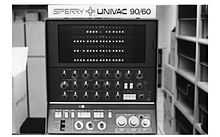UNIVAC Series 90

The Univac Series 90 was a family of mainframe class computer systems from UNIVAC first introduced in 1973.[1] The low end family members included the 90/25, 90/30 and 90/40 that ran the OS/3 operating system. The intermediate members of the family were the 90/60 and 90/70, while the 90/80 was the high end system. The 90/60 through 90/80 systems all ran the Univac’s virtual memory operating system, VS/9.
The Series 90 systems were the replacement for the UNIVAC 9000 series of low end, mainframe systems marketed by Sperry Univac during the 1960s. The 9000 series systems were byte-addressable machines with an instruction set that was compatible with the IBM System/360. The family included the 9200, 9300, 9400, and 9480 systems; the 9400 and 9480 ran a real memory operating system called OS/4.[2] As Sperry moved into the 1970s, they expanded the 9000 family with the introduction of the 9700 system in 1971. They were also developing a new real memory operating system for the 9700 called OS/7.
In September 1971, the RCA Corporation announced that it was abandoning the computer industry and Sperry acquired RCA’s Computer division. RCA had marketed the Spectra 70 Series (70/15, 70/25, 70/35, 70/45, 70/46, 70/55, 70/60, 70/61) that were compatible with The IBM System/360 series and the RCA Series (RCA 2, 3, 6, 7) competing against the IBM System/370. These systems all ran RCA’s real memory operating systems, DOS and TDOS. RCA’s virtual memory systems, the Spectra 70/46 and 70/61 and the RCA 3 and 7, could also run their Virtual Memory Operating System, VMOS. VMOS was originally named TSOS (Time Sharing Operating System), but was renamed in order to expand the system beyond the time sharing market. TSOS was the first mainframe, demand paging, virtual memory operating system on the market. At the time, IBM was in the process of transforming OS/360 to a virtual memory system through the OS/VS1 and OS/VS2 (SVS) operating systems, on the way to the subsequent release of MVS.
In January 1972, Sperry officially took over the RCA base, offering the Spectra 70 and RCA Series computers as the UNIVAC Series 70.[3] Sperry would ultimately rethink the 9700 and killed OS/7. They redesigned the 9700, added virtual memory and renamed the processor the 90/70. VMOS was modified for the new hardware platform and was named VS/9. The 90/70 was then modified to produce the 90/60, a slower version of the 90/70 that would be sold at a lower price. In 1974, Sperry would also replace the low end 9000 systems with the low end Series 90 Family— the 90/25, 90/30 and 90/40 running the OS/3 operating system.
A number of the RCA customers continued with Sperry, and the 90/60 and 90/70 would provide an upgrade path for the customers with 70/45, 70/46, RCA 2 and 3 systems. In 1976, Sperry added the 90/80 at the top end of the Series 90 Family, based on an RCA design, providing an upgrade path for the 70/60, 70/61, RCA 6 and 7 systems.
The RCA base was very profitable for Sperry and Sperry was able to put together a string of 40 quarters of profit. Sperry was also offered their own 1100 family of systems and the 1100/60 provided an entry level system for the Series 90 customer base. Around 1982-83, Sperry announced they would cap the Series 90 Systems and would decommit the VS/9 operating system to concentrate on the 1100 series. After this announcement, Sperry would stumble on the revenue side ending their run of profitable quarters, resulting in some downsizing. The Series 90 Systems suffered from pressure from the IBM 4300 series systems that offered superior price performance and may have induced Sperry to concentrate on the 1100. In a short time Digital Equipment Corporation, with their flagship VAX line of midrange computers would pass Sperry in terms of total revenue to become the number two U.S. computer manufacturer after IBM.
References
- ↑ Belzer, Jack (ed); Holzman, Albert G. (ed); Kent, Allen (ed) (1979). Encyclopedia of Computer Science and Technology: Volume 13 - Reliability Theory to USSR: Computing in. CRC Press. p. 336.
- ↑ "Records of Sperry-UNIVAC Acc. 1825 Record Group 2". Acc. 1825 Record Group 2 - The Records of Sperry-UNIVAC Series VI: Technical Records - Software Publications Files, Continued.
- ↑ Gray, George T.; Smith, Ronald Q. (2001). "Sperry Rand's Third-Generation Computers 1964-1980". IEEE Annals of the History of Computing (IEEE Computer Society) 23 (1): 3–16. doi:10.1109/85.910845.